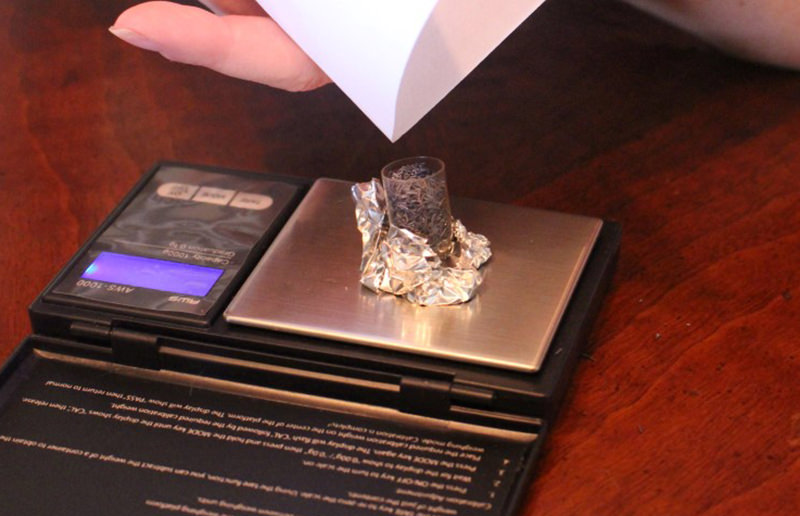
Goats have notoriously high copper needs—needs that in many places are not met even with grazing, high-quality feeds and loose minerals. Our farm is such a place.
Our soil—and therefore our grass—is copper poor, and we have the double whammy of being iron-rich. Iron binds to copper in the goat, making it less available through normal metabolic processes. Not all farms will have this particular combination of issues, but many will find that their goats just aren’t getting enough copper.
There are great articles available to help you recognize symptoms of copper deficiency, and as with all health issues, you should speak with your vet if you have concerns. If you are experiencing copper deficiencies, the No. 1 way our farm takes care of it is with copper bolusing. Here’s a short tutorial on how to make and administer these copper supplements.
What You’ll Need:
- weight tape
- full-sized copper boluses for cows (When we started, there were no boluses sized for goats, so we had to break down cow boluses into the correct doses. Now goat boluses are available, but they only come in 2g and 4g sizes. My smallest goats—at 140 pounds—require more than 6 grams, so we still have to repackage cow boluses.)
- properly sized empty gelatin capsules (We use a #13 for our full-sized Nubians. It can hold up to 9g of copper rods, which will cover goats up to 198 pounds.)
- gram scale
- sheet of paper, creased down the center
- small piece of aluminum foil
- small sandwich bags
- plastic bolusing gun sized to accept the capsules you are using (available at most feed stores)
Getting Started

Measure and record all of your goats’ weights. We do this the day before bolusing—usually while they are on the milk stand. Calculate the weight of copper rods needed for each goat. Divide their weight by 22 to get the number of grams.

In our herd, we have a lot of goats that are the same size. I like to group them and make all of the boluses for that weight group at once. I put the boluses in a ziplock baggie with the names of the goats, their weight and the bolus size.
Making Your Copper Boluses

Take your piece of foil and wad it up to make a stand for your capsule bottom. Place the capsule in the stand, on the scale and hit the tare button. This will set the weight to zero for your materials.

Empty a full-sized cow bolus onto your creased piece of paper. Use the crease to help you slowly pour the rods into the waiting capsule. Stop when you hit your target weight. I go to the nearest tenth of a gram: A tenth on either side will not affect your outcome.

Place the top on your bolus and put it in your marked baggie. Repeat until all of your boluses are made.

Administering The Boluses
This is best handled as a two-person job: one to hold the goat in place and one to shoot the pill. We always bolus on the milk stand—even our bucks—to help keep them still. If you have a milk stand, use it; if you don’t, consider building a headgate. Otherwise, you can do it the old-fashioned way, which is to straddle them and hope they don’t take off.

Person one will open the goat’s mouth and hold its head level. Keeping the head level helps ensure the esophagus is open but the trachea not.

Person two will place the bolusing gun as far back into the mouth as possible, making sure the tongue is down and out of the way before releasing the bolus. You may need to work on this a while before it is placed right, including wiggling it a bit to get the goat to relax its tongue. Once it is relaxed, make sure you’re way back there, and release.
Person one should hold the mouth shut until a swallow is felt or heard as person two gently removes the gun.
You will have some failures. If it is clear that the bolus did not go down, allow the goat to spit it out quickly. You only get two or three chances before the capsule breaks or gets too slimy to use. It was once thought that the capsule could not be chewed, that it had to go down unbroken. That is not actually true, but no goat will eat all of the rods on their own, so if they start to chew, try to retrieve it to try again. You don’t want to guess at what percent of the dose they received.
An Alternative To Bolusing
I have friends who do not use capsules. They just hide the rods in a soft treat that their goats love, such as fruit, marshmallows or fig newtons. Research says this is as effective as bolusing, so long as they eat it all.
I can’t find a single or even two or three treats that all of my goats will eat. My goats are all spoiled and picky. Furthermore, I have a few 200-plus-pound goats who need 9 grams or more of copper. It’s hard to hide quantities that large. Even though using the gun is a bit of a pain, we have found it the quickest, easiest way to effectively do a herd of our size. As with all things goat, you may find another way that works better for you and your herd.




